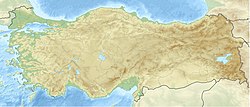Aydıntepe underground City
Ancient city in Bayburt Province, Turkey From Wikipedia, the free encyclopedia
The Aydıntepe underground City (Turkish: Aydıntepe Yeraltı Şehri) is an ancient underground city in Aydıntepe district of Bayburt Province, Turkey.[1] It is located 25 km (16 mi) northwest of Bayburt beneath a residential area.[2][3]
Aydıntepe Yeraltı Şehri | |
| Location | Aydıntepe, Bayburt Province, Turkey |
|---|---|
| Region | Black Sea Region |
| Coordinates | 40°23′18″N 40°09′02″E |
| Type | Underground city |
| Length | 1 km (0.62 mi) |
| Height | 2 m (6.6 ft) |
| History | |
| Material | Volcanic tufa rock |
| Founded | 3,000 years ago |
| Abandoned | yes |
| Site notes | |
| Excavation dates | 1988–2008 |
| Management | Aydıntepe Municipality |
| Public access | yes |
Description
Summarize
Perspective
Discovered by coincidence during excavation works for a hotel building construction in 1988 by Hasbi Okumuş,[3] -to some sources in 1998–[4] the underground city at Aydıntepe features chambers, halls and hallways carved out of volcanic tufa rock formation without using building materials.[2] It is situated 2–5 m (6.6–16.4 ft) under the surface. The chambers and the halls are connected with 1 m (3.3 ft)-wide and 2 m (6.6 ft)-high hallways stretching over about 1 km (0.62 mi) in length. There are eight conical shafts over the hallways, which are believed to be for observation or ventilation purposes.[2][5][6] Some original entrances and structures are now inaccessible because of collapse or later construction.[7]
A round rock piece of 1.5 m (4.9 ft) diameter stands as a door at the entrance to close the underground city from the outer world when needed. The tombs above the underground city and the wall figures inside it point out to a history of three millennia including the Late Roman or early Byzantine era.[3][8] It was used by Christians as well as by Muslims. Various people sheltered in the city at different times, hiding from religious persecution or war.[8] Inside the underground city, there are cellars, storage rooms, water sources, and a pool.[2] The city was well-fortified while still in use; it once housed a closing device and guard chamber.[7]
The site was archaeologically researched, and was put under protection by the Cultural and Natural Heritage Preservation Board in 2008. About 850 m (2,790 ft) long part of the underground city covering an area of 1,200 m2 (13,000 sq ft) is open to the public for visit.[2][3]
References
External links
Wikiwand - on
Seamless Wikipedia browsing. On steroids.
